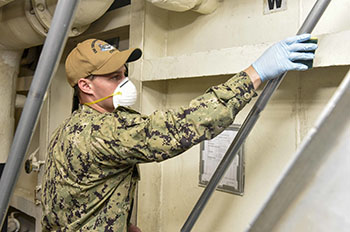Vision
Army Public Health Nursing is the premier globally agile public heath force that protects, sustains, and enhances Total Force readiness through evidence-based public health services.
 Mission
Mission
Army Public Health Nursing enables Total Force readiness through promoting population-focused health, mitigating disease and injury, assuring Force Health Protection, informing policy, and responding to emerging health threats.
Resources
The Army Public Health Nursing milBook page provides a professional platform for sharing best practices and key documents, posting updates, providing answers to commonly-asked questions, and enhanced communication within the field.
 Evidence-Based Practice
Evidence-Based Practice
Army Public Health Nursing is currently re-defining the practice and scope of services in accordance with Army Transformation and Army Preventive Medicine updated services requirements; American Nursing Association standards; and the core functions and essential services outlined by the Association of State and Territorial Directors of Nursing Public Health Nursing Practice Model (ASTDN, 2003).
Army Public Health Nursing defined:
The American Nurses Association (1980) defined professional nursing as the "The diagnosis and treatment of human responses to actual or potential health problems."
According to Stanhope and Lancaster (2004), a distinct difference between community health nursing and public health nursing practice exists.
"Community health nursing is the synthesis of nursing theory and public health theory applied to promoting, preserving, and maintaining the health of populations through the delivery of personal health care services to individuals, families and groups. The focus of community health nursing practice is the health of individuals, families, and groups and the effect of their health of the community as a whole."
"Public health nursing practice is the synthesis of nursing theory and public health theory applied to promoting and preserving the health of populations. The focus of public health nursing is the community as a whole and the effect of the community's status (including health care resources) on the health of individuals, families and groups. Care is provided within the context of preventing disease and disability and promoting and protecting the health of the community as a whole." (Stanhope & Lancaster, 2004)
Based on these definitions, the Army's Public Health Nursing practice has become a synthesis of community health and public health nursing that occurs in a military environment.
Public Health Management System Instrument for Army Public Health Nursing
The PHMS Instrument for Army Public Health Nursing is built on the National Public Health Performance Standards Program (see http://www.cdc.gov/nphpsp/index.html); specifically, on the Local Public Health System Performance Assessment Instrument (http://www.cdc.gov/nphpsp/TheInstruments.html). The NPHPSP is framed on the Public Health Essential Services noted below:
PUBLIC HEALTH ESSENTIAL SERVICES
Essential Service
#1: Monitor Health Status to Identify Community Health Problems Essential Service
# 2: Diagnose and Investigate Health Problems and Health Hazards in the Community Essential Service # 3: Inform, Educate, and Empower People about Health Issues Issues Essential Service
# 4: Mobilize Community Partnerships to Identify and Solve Health Problems Essential Service
# 5: Develop Policies and Plans that Support Individual and Community Health Efforts Essential Service
# 6: Enforce Laws and Regulations that Protect Health and Ensure Safety Essential Service
# 7: Link People to Needed Personal Health Services and Assure the Provision of Health Care when Otherwise Unavailable Essential Service
# 8: Assure a Competent Public and Personal Health Care Workforce Essential Service
# 9: Evaluate Effectiveness, Accessibility, and Quality of Personal and Population-Based Health Services Essential Service
# 10: Research New Insights and Innovative Solutions to Health Problems
The APHN-PSR is part of the U.S. Army Public Health Management System. The PHMS is a web-based tool developed by the MEDCOM Proponency Office for Preventive Medicine. The purpose of the PHMS is to:
1. Define public health/preventive medicine roles and missions at the local, regional and headquarters level
2. Validate the public health/preventive medicine mission and its value
3. Provide performance measures and benchmarks
4. Identify appropriate fiscal and human resources
The PHMS provides easy access to program management resources such as standard operating procedures, preventive medicine policy and strategic documents, and work plan information. Also, the PHMS feeds key metric data to the AMEDD Command Management System, where it is reviewed on a regular basis by The Surgeon General and leadership.
Acknowledgement: The National Association of County and City Health Officials and the Centers for Disease Control and Prevention were principal players in developing the National Public Health Performance Standards Program instrument. Other collaborative partners included the Association of State and Territorial Health Officials, the National Association of Local Boards of Health, the American Public Health Association, and the Public Health Foundation. Academic partners representing the Association of Schools of Public Health also made considerable contributions